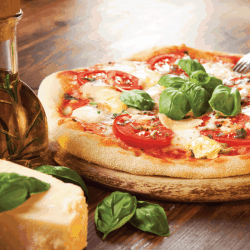Making homemade pizza is a great way to get your family together to cook a delicious meal! One of the biggest things to worry about when making your own pizza is figuring out how to properly cook it. There are special pans and trays to cook your pizza on but do they need greased or prepared at all? We have scanned the internet so we can help you use your pizza tray the best way possible!
To avoid any problems while cooking your pizza, you should grease the tray or pan you are using. There are several different options when choosing what to grease your tray with. Make sure to spread your chosen oil, or other greasing methods, evenly across your tray. Choosing to not grease your pizza tray could affect how your pizza cooks and your ability to easily remove it.
Preparing and cooking your own pizza is a great way to save some money on nights where you're craving this classic Italian dish. To make sure your homemade pizza turns out amazing, you have to not only grease your tray but prepare it properly to be used. Keep reading below to make sure that your pizza-making experience goes as smoothly as possible!
![A delicious and perfectly cooked margarita pizza topped with sliced cherry tomatoes and mozzarella cheese, Do You Need To Grease A Pizza Tray? [Tips On How To Prepare One]](https://kitchenseer.com/wp-content/uploads/2021/06/Do-You-Need-To-Grease-A-Pizza-Tray-Tips-On-How-To-Prepare-One-667x1000.png)
How To Properly Prepare Your Pizza Tray
The last thing you want on pizza night is to spend all of that time putting together your dish only to have it become ruined. Unfortunately, it's fairly easy for pizza to be improperly cooked. There are a few different reasons this can happen - from the oven to how thick the pizza itself is. However, one of the biggest pizza crimes is not preparing your cooking pan correctly. Here are some steps to take to ensure pizza night is a success!

Why Should You Grease Your Pizza Tray?
There are a couple of important reasons why you should grease your pizza cookware. The most important reason is so that it doesn't stick. Having a perfectly cooked pizza can be ruined very quickly if you can't get it out of the pan. Not to mention the terrible thought of trying to scrape your pizza off the tray only to watch it fall apart.
The secondary reason to grease your pizza is to help enhance its flavor. Depending on what you use to grease your pizza tray, it's going to add something to your dish. Whether it just adds a subtle flavor or even improves the texture of your pizza's crust. It's definitely worth it to get the most out of your pizza!
How To Properly Grease Your Pizza Tray?
The first step is to pick your preferred greasing ingredient. Depending on what you choose, the application may vary a little but the process is fairly similar regardless. You can put a small amount of oil directly onto the tray or leave the oil off to the side. Then use a paper towel, brush, or another spreading tool to evenly distribute your grease across the entire top surface of your tray. If you leave your preferred grease off to the side, simply dip your tool in it and then spread it onto your tray.
What Do You Grease Your Pizza Pan With?
There are some obvious choices for this job and some that you may not have thought of previously. Each choice may affect the texture and taste of your finished pizza a little differently. Due to this, it may be important to try some different choices until you find one that you really love!
Oil
The most obvious choice for this job is standard cooking oil. Olive oil is generally the standard for greasing pizza trays. It does the job of making your tray nonstick very well. Olive oil also adds a subtle flavor to your pizza that goes well with it. The texture of your pizza's crust is also elevated because of olive oil.
Aside from olive oil, you can use most cooking oils to do the job. Just make sure the oil you choose doesn't have too low of a smoke point and that its flavor will go well with the dish.
Click here to shop for olive oil on Amazon.
Butter
Another very popular choice for this job is butter. Simply spreading some butter onto the tray with a tool or just using the stick of butter directly also does a great job. Many classic pizza makers swear by butter for this job because of the obvious flavor it adds to the pizza. The flavor of butter goes very well with any carb really. For a healthier spin on this idea, you could also use margarine. This will work similarly but you may lose some of that traditional flavor.
Shop for butter on Amazon here.
Cornmeal
Have you ever wondered what that thing is that pizza restaurants do that you haven't been able to duplicate at home? Chances are that thing is using cornmeal on the pizza trays! If you want to avoid using fat on your pizza, then cornmeal is a great and very traditional way to make sure your pizza doesn't stick. It also adds a unique flavor and texture to the crust of your pizza.
You can also use flour on your pizza pan but that doesn't have all of the benefits of cornmeal. The flour will keep your pizza from sticking but it would add anything special to the flavor. That's why cornmeal is usually chosen over it. Many professional and at-home chefs also use a combination of cornmeal and oil. Spreading some olive oil onto your tray and then sprinkling on some cornmeal is a match made in heaven for your pizza's crust!
More Pizza Tray Thoughts
Greasing your pizza tray is probably the most important step to ensuring that it does a great job. After that though, there may be some other questions that come up. There are different kinds of shapes of pizza pans so can they all be greased the same? Is there anything else you can do to your pizza tray to get it ready for giving the best-baked pizza possible? Here are some other pizza tray questions that may help you.
Why Are There Holes In My Pizza Pan?
Depending on what kind of pizza tray, or pan, you have it may be mesh or have a bunch of holes in the bottom of it. This is a very common occurrence for pizza cookware. The perforated bottom of these pans helps to cook your pizza faster. They also produce a crispier crust than pans without the perforations. So if you love your pizza to have a crispier crust, then ensure that you are using one of these trays!
Click here to shop for perforated pizza pans on Amazon.
Do You Grease A Pizza Pan With Holes?
In a short answer, yes you do. Perforated pans need to be prepared the same way as a solid pizza tray. There may be less surface area but what there is will still stick to your pizza while it cooks. Due to the holes, it's not the best practice to just put some oil in the pan as it will run through and make a mess.
Depending on what you use, you should set it off to the side and spread it onto the pan using a tool. This works well with oils. With butter, you should still be able to apply it directly to the pan since it's thicker. Cornmeal and flour might be a bit thicker. The best practice is to put something under your perforated tray to catch the cornmeal that goes through the holes. You can also apply the cornmeal directly to the crust instead of onto the pan.
Should I Preheat My Pizza Pan?

This is a somewhat debatable topic in the world of pizza making. Some swear by it. They state that putting a pizza in an already hot pan in the oven will help direct the heat more quickly to the crust. This may help ensure that the center of your pizza doesn't cook before the crust is to your liking. Others state that this step isn't necessary to achieve your desired outcome.
The best way to find out if this method is best for you is to simply try it. If you find that no matter what you do, your crust is never cooked as much as you'd like when the middle is done, then this might be what you need. In this case, also consider using a perforated pizza tray if you are not already. That will also help alleviate this problem.
Final Thoughts Before You Bake
Making pizza at home is a great way to have some fun and test your cooking skills. To avoid damaging that experience, make sure that you grease your pizza tray. Even if it's nonstick you should still grease it. Regardless of whether you use oil, butter, cornmeal, or a combination, it will stop your pizza from sticking and add some great flavor and texture. Now that you can make the perfect at-home pizza all you have to do is choose the toppings!
To learn more about which dishes you should be greasing in your kitchen click on the links below!
Should You Grease The Casserole Dish?
Should You Grease or Line a Springform Pan
Do You Need to Grease a Lasagna Pan?










